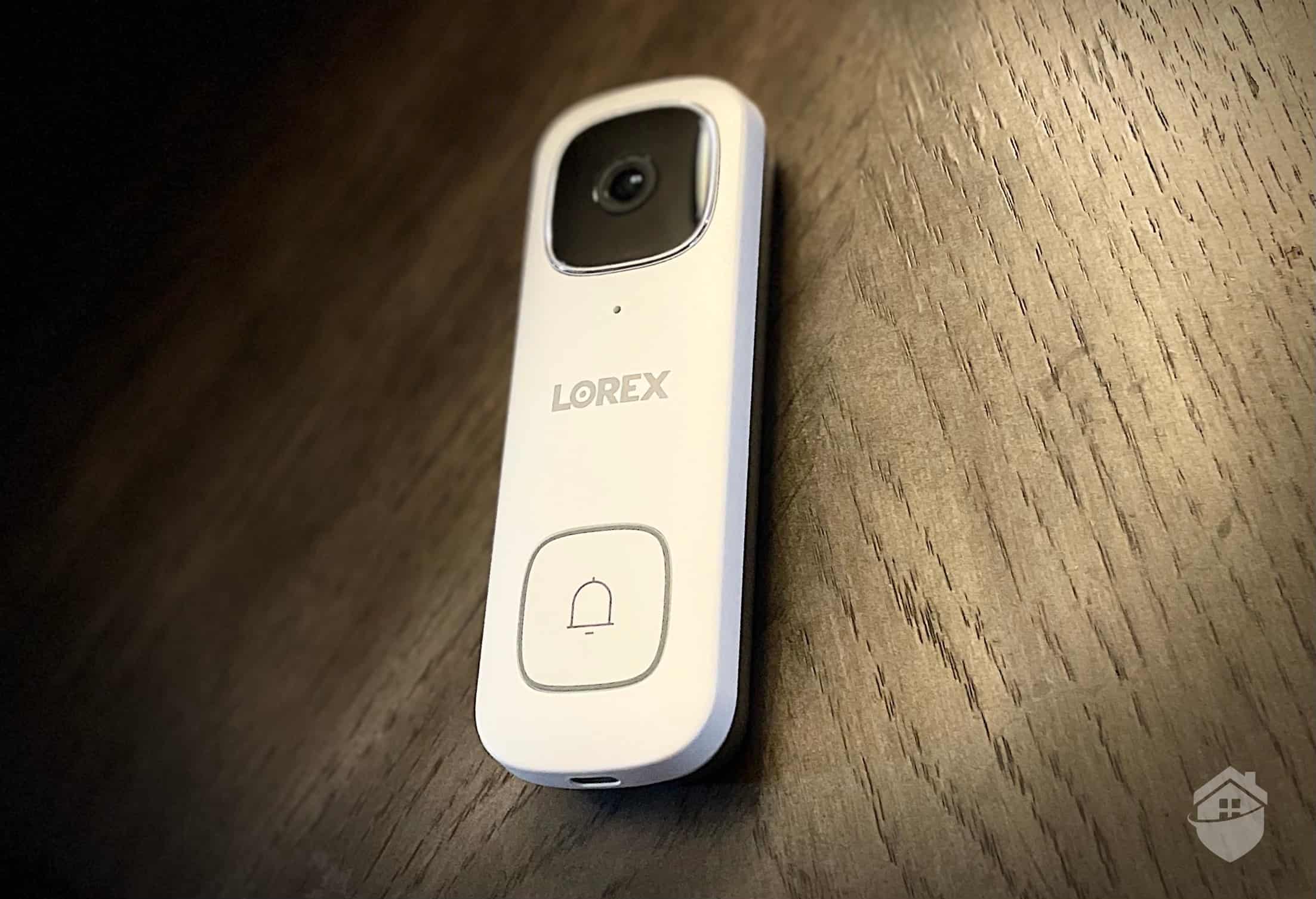The doorbell camera market has exploded in recent years, but we’ve noticed that a lot of manufacturers lock core features like video recordings behind subscriptions. Even worse, these subscriptions can cost you around $10 per month on top of the hardware cost.
If you’re on a budget, our experts researched and assessed the best smart doorbell options that don’t require monthly fees. Do they offer enough functionality? What should you look for when buying no-subscription video doorbells? In this video doorbell guide, we’ll cover everything you need to know.
Understanding No-Subscription Video Doorbells
The truth is, no-subscription doorbell cameras work a little different than your typical video doorbells that require a subscription. Here are some things to keep in mind.
What Makes a Doorbell “No-Subscription”
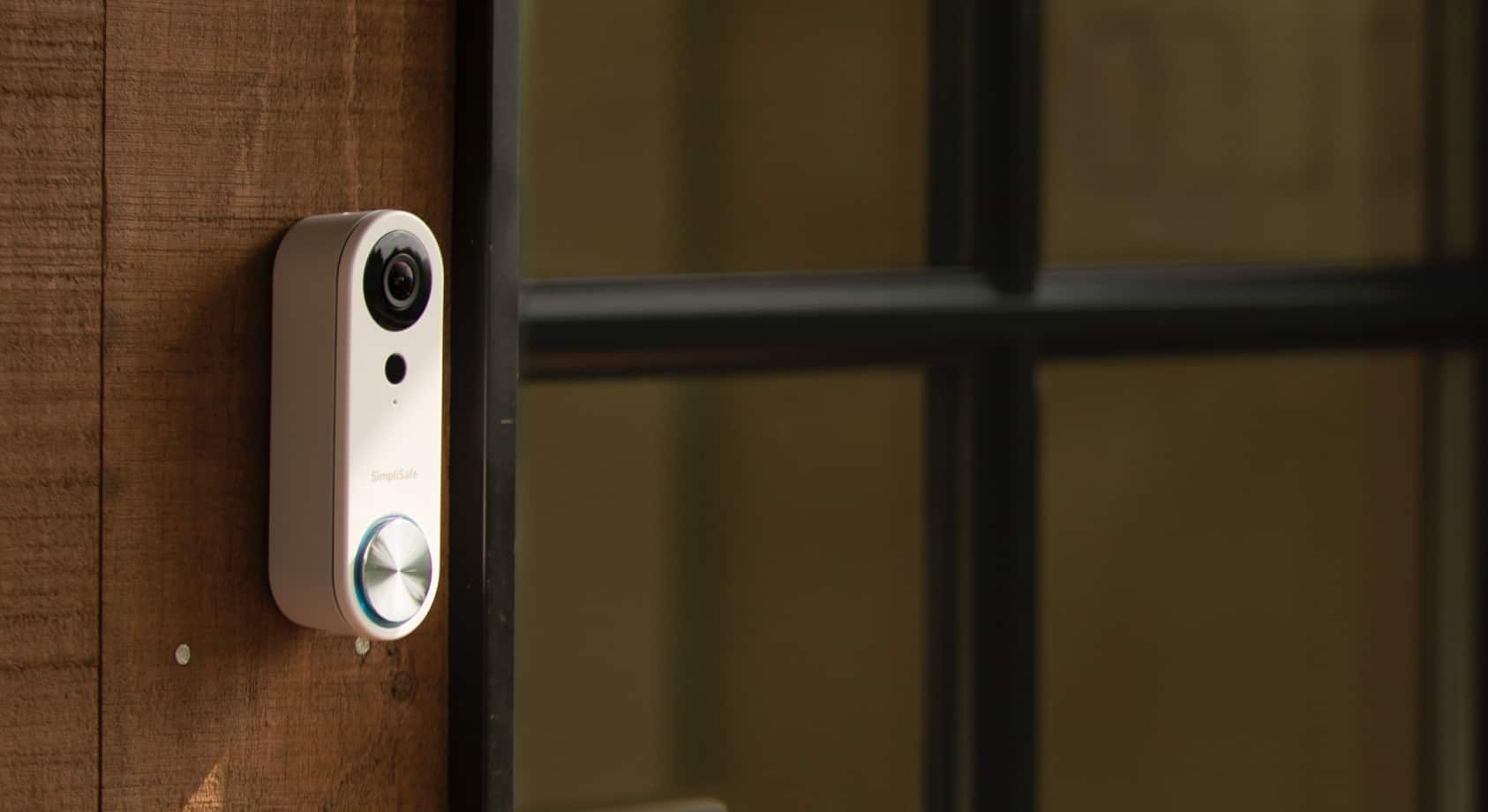
Our SimpliSafe Video Doorbell Pro worked alongside our full SimpliSafe security system with no subscription.
Without a subscription, a doorbell camera likely stores videos locally, not on the cloud like typical doorbell cameras do. The subscription-free model means they have to store videos on a removable SD card, built-in memory, or a connected hub.
Additionally, all core features are included as part of the initial hardware purchase. Subscription-based doorbell cameras hide features such as package detection and facial recognition behind a paywall, but their no-subscription counterparts don’t do this.
That being said, expect to see less advanced features. Some smart features – facial recognition, for example – require higher processing power that is only possible through cloud processing. And since everything is done locally with no-subscription models, they might lack advanced features that need cloud processing.
FYI: Look for doorbells that explicitly state “no monthly fees required” rather than “subscription optional”—the latter often means limited functionality without paying.
Our Three Favorite No-Subscription Smart Doorbells
After testing seven no-subscription smart doorbells, Lorex, Wyze and Eufy earned our recommendation. Their video quality, storage options, and free detection features put them above the competition.
1. Lorex — Best Image Quality
With up to 4K resolution, Lorex offers the clearest image quality we’ve experienced with a smart doorbell, even counting ones that require a subscription. Without a subscription, you still get person detection, as well, which makes for more useful alerts.
All of their models come with a pre-installed 32 GB microSD card that you can upgrade to a 256 GB microSD card if you want. We recommend the upgrade if you opt for their 4K model. That 32 GB card can only store a little over an hour of footage.
What We Like:
- MicroSD card included for internal storage
- Several models to choose from with prices starting at $89.99
- Person detection available without a subscription
- Color night vision
What We Don’t Like:
- No option to integrate with a full security system
- Limited home automation capabilities
- Sporadic loading issues with the Android app
FYI: You can further expand your Lorex storage with one of their NVR systems. This enables up to four TB of storage, or about 16 times more capacity than the max 256 GB microSD card. It can also connect to other Lorex cameras. Check out our review of Lorex’s cameras for all the details.
2. Wyze — Most Affordable
When you’re working with a tight budget, Wyze offers prices that are hard to ignore. Their smart doorbells start at about $45, half the price of Lorex’s cheapest model. They don’t skimp on many features, either, with 2K resolution and color night vision.
Those low prices do come with a couple compromises, though. For instance, to access their people detection feature, we had to subscribe to their cloud storage plan. Lorex offers this feature for free.
What We Like:
- Inexpensive
- 2K resolution and color night vision
- Internal storage option with a microSD card
- Automated voice prompts can deter criminals
What We Don’t Like:
- MicroSD card for internal storage must be purchased separately
- People, pet, and vehicle detection requires a subscription
- No battery-powered option makes for a difficult installation
>> Read More: Wyze Home Security Camera Review 2025
3. Eufy — Best for Package Protection
If thwarting porch pirates is one of your main reasons for getting a smart doorbell, we recommend Eufy’s E340 video doorbell. It features two lenses, one with a normal front-facing view and one with a downward view. While we were testing Eufy’s video doorbell, we used the downward view lens to keep an eye on our packages until we got home from work to bring them inside.
On top of that, Eufy makes all of their features, including person-detection, available without a subscription. They only feature 8 GB of local storage, though, and it’s not as easy to expand as Lorex or Wyze. Eufy makes you buy their HomeBase S380 which costs $150 if you want more storage. It works similarly to Lorex’s NVR system.
What We Like:
- Two lens system is ideal for keeping an eye on packages
- Hardwired and battery-powered options
- 16-foot night vision with three LED lights
- Easy-to-charge quick-release battery pack
What We Don’t Like:
- Expanded storage requires an external drive that costs $150
- Noticeable latency when live streaming footage
- Plastic mounting bracket is more flimsy than we’d like
Local Storage vs. Cloud Storage
Local storage means your doorbell can store video footage without needing a remote server. This approach offers several advantages, including:
- Complete privacy control
- No ongoing costs
- Continued functionality during internet outages
- Expandable storage
On the other hand, while cloud storage is convenient for remote access and automatic backups, it leaves room for better reliability. An internet outage can affect your doorbell’s recording function. Features that require cloud processing won’t work as well. This can leave you without access to important security features when they matter.
Key Features to Look For
Now let’s go over a few key features you should look for to minimize the negative aspects of doorbell cameras without subscriptions while maximizing the positive aspects.
Essential Security Features
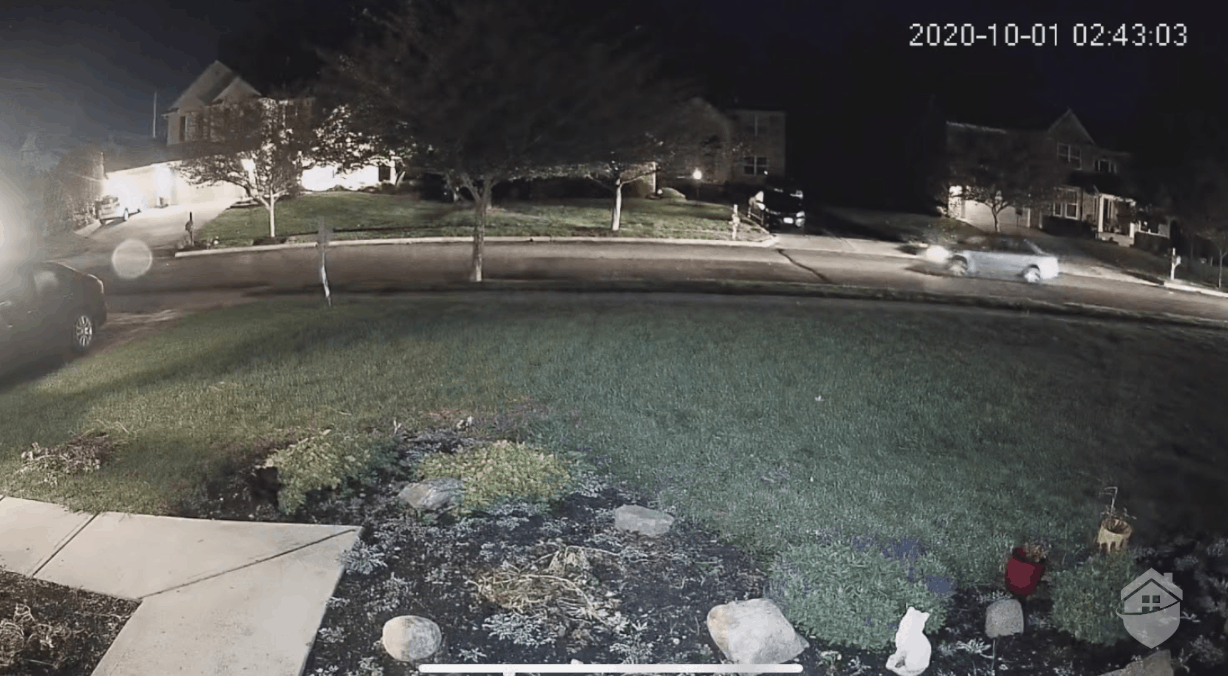
The full color night vision on the Lorex Video Doorbell provided us with clear footage all night long.
Motion detection is essential to any good video doorbell. But you need more than just detection. It should be smart enough to balance security coverage and false alarm prevention. Features like customizable motion zones and adjustable sensitivity settings can help. Some smart doorbells can also tell apart people, packages, and vehicles, although this feature is not always included in subscription-free smart doorbells.
Two-way audio is also critical. The sound quality should be clear in both directions. However, our tests consistently show that budget models often sacrifice audio clarity. You should look for a mid-tier or high-end model that offers clear audio, ideally with noise suppression.
Lastly, you should consider night vision performance. It varies dramatically between models. Infrared doorbell cameras use Infrared LED lights to offer clear but black-and-white footage at night. Meanwhile, models like the Lorex video doorbell we reviewed have built-in mini-spotlights to provide color night vision.
Pro Tip: Infrared night vision is more discreet because Infrared light is invisible. If you don’t mind occasionally startling your guests with bright lights, though, go with doorbell cameras with color night vision.
Smart Home Integration
Even some doorbell cameras that don’t require a subscription support integrations with third-party smart home platforms. This includes Alexa and Google Assistant integrations. That means if you have a smart display (like the Nest Hub Max or Echo Show), you’d be able to ask your smart assistant to stream live video to it. Essentially, you’d be able to answer your door hands-free.
Additionally, some models offer advanced integration features like triggering smart lights when they detect motion. Just keep in mind these features are more likely to require a subscription.
Installation and Power Requirements
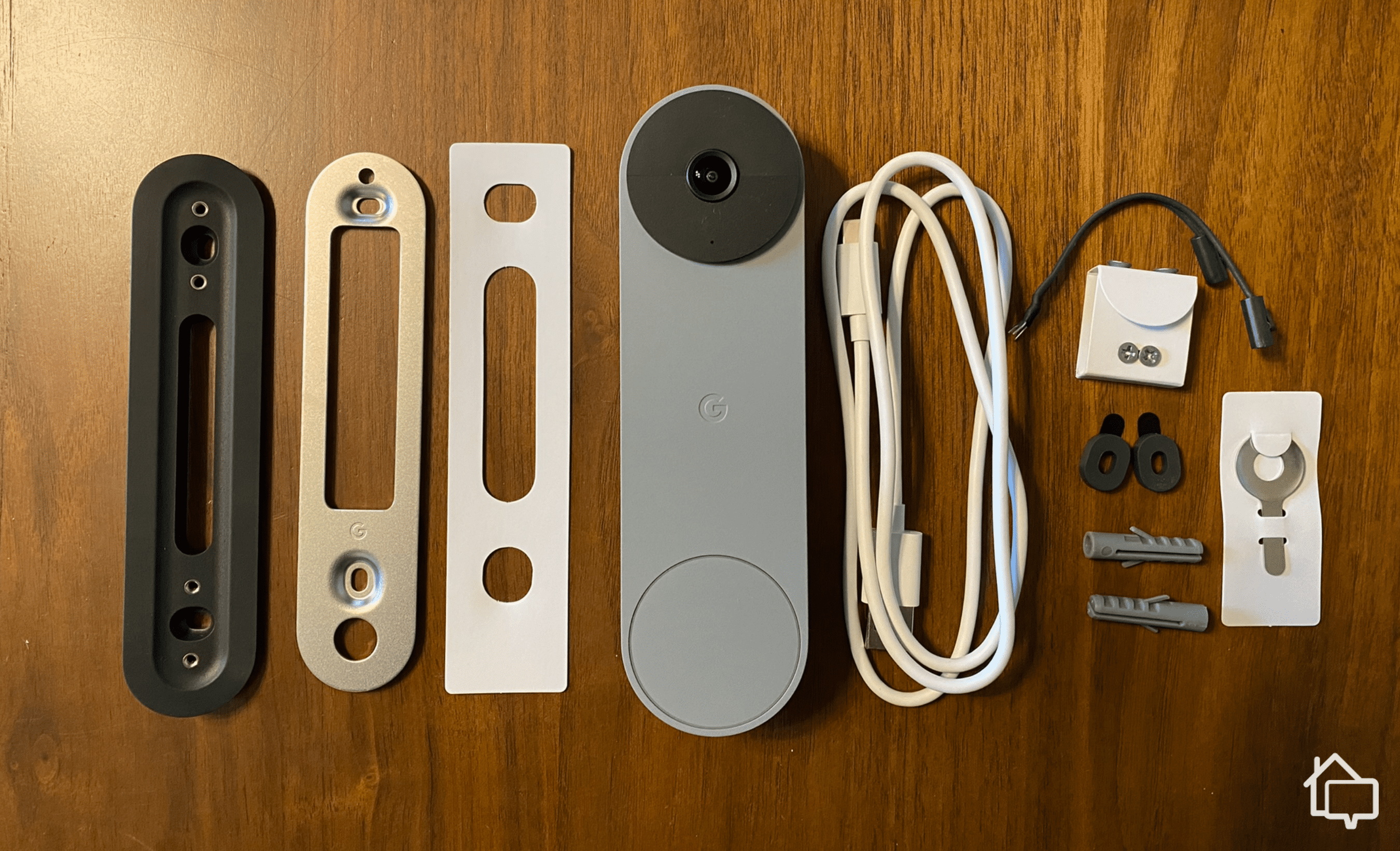
Our Google Nest Video Doorbell came with all the components we needed to install it.
Doorbell cameras are either battery-powered or hardwired to an existing doorbell setup.
Battery-powered models offer installation flexibility but require regular charging or battery replacement. In our experience, the typical battery life is two to six months, depending on factors such as usage frequency and environment. Batteries drain faster in colder temperatures.
Wired installations provide consistent power, but the installation itself is more tedious. If you’re uncomfortable DIYing it, professional installation may be necessary. Plus, you have to ensure your home’s built-in wiring is compatible. The good news is, in our experience, most homes built after 1990 have adequate wiring.
Pro Tip: Check your existing doorbell transformer voltage before purchasing — most smart doorbells require 16-24 volts AC to function properly.
How to Install and Set Up Subscription-Free Smart Doorbells
The set-up process for all doorbell cameras is the same whether the manufacturer requires a subscription or not. In our experience, the quality and level of support is also not affected. This is particularly true for standalone doorbell cameras. Doorbell cameras that come with a security system often require a subscription, and they also often offer the option for in-house professional installation.
That said, we’ve installed dozens of smart doorbells ourselves for testing, and we know that it’s easy to DIY. Here’s how.
Pre-Installation Planning
Successful installation begins with proper planning and preparation.
If you have a wired doorbell, check that your existing wiring is compatible. If you’re not sure, you can use a multimeter to confirm that the voltage is 16 to 24 VAC, which is the most commonly compatible with doorbell cameras. If not, you might need to buy an adapter from the manufacturer, or get your doorbell setup rewired by an electrician.
You should also evaluate your Wi-Fi signal strength at the installation. You can use your smartphone’s Wi-Fi signal indicator. Weak signals cause connection issues, delayed notifications, and reduced battery life in wireless models.
Pro Tip: Also check your smart doorbell’s Wi-Fi compatibility. A dual-band model means it can connect to either 2.4 GHz or 5 GHz networks. Some, however, only support the former. If that’s the case, ensure your network’s 2.4 GHz band is available at the installation location.
Step-by-Step Installation Process
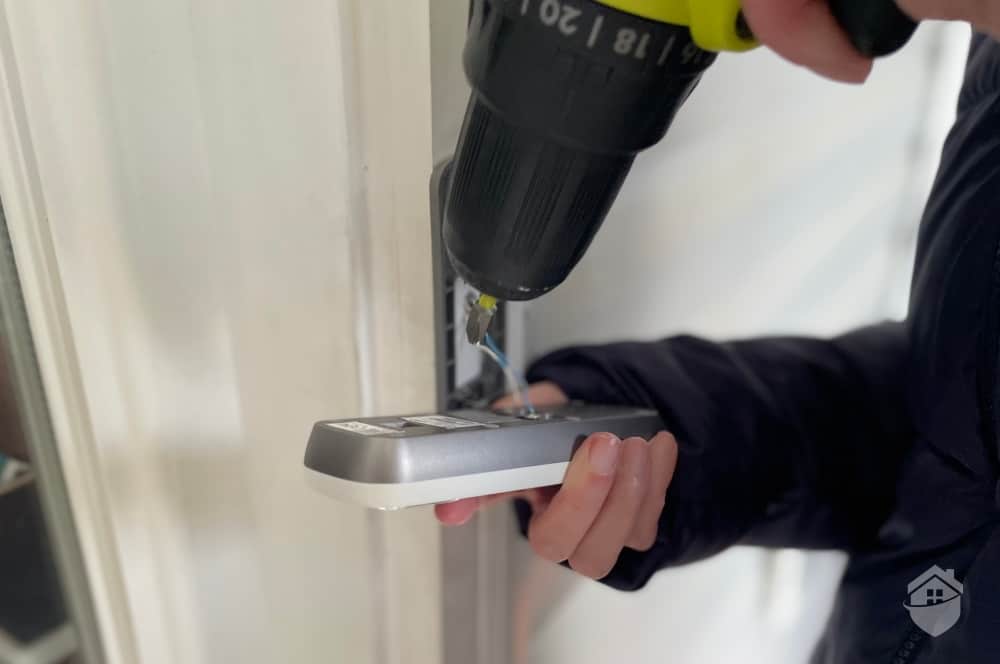
We had to break out our drill to install the hardwired Lorex Video Doorbell
With a battery-powered doorbell, you’d often only need to install the faceplate, install the battery pack, and snap the doorbell body into place. That’s it. After that, it’s all about setting up the app and making sure the smart doorbell works.
Installation for wired doorbells is a little more involved because they need wiring. Here’s a step-by-step overview for installing a hardwired video doorbell, such as the SimpliSafe Video Doorbell Pro we tested:
- Power Down: Turn off electricity to your existing doorbell at the circuit breaker for safety.
- Remove Old Hardware: Carefully disconnect existing doorbell wiring and remove mounting hardware.
- Install Mounting Bracket: Use the provided template to mark screw holes and start drilling.
- Connect Wiring: Match wire connections according to the manufacturer’s manual.
- Attach Device: Secure the doorbell to the mounting bracket and turn the breaker back on.
- Configure Settings: Download the manufacturer’s app and follow setup instructions for Wi-Fi connection and initial configuration
Installation Tip: Take photos of your existing wiring before disconnection. Doing so might help troubleshoot connection issues if problems arise.
How to Troubleshoot Common Installation Problems
The most common installation issue stems from Wi-Fi connectivity. Distance, interference, or network configuration can all cause problems. Try leaving the door open. If the smart doorbell connects, it’s most likely that it’s not getting enough signal outside when the door is closed. A Wi-Fi extender will solve this issue.
Insufficient power from the transformer can also cause failures in wired doorbells. If it doesn’t power on or if it turns off intermittently, have an electrician check your existing wiring. Even if it meets the specifications your smart doorbell requires, there may be underlying issues like short circuits.
Mounting surface compatibility varies between doorbell models. Brick, stucco, or vinyl siding may require specific mounting hardware or professional installation for secure attachment. All of the best security systems with video doorbells offer professional installation for these scenarios.
Comparing Subscription vs. No-Subscription Models
Is a no-subscription smart doorbell the right choice for you, though? Or will you be better off with a doorbell that requires a subscription. Let’s compare the two:
| Feature | No-Subscription Models | Subscription Models |
|---|---|---|
| Monthly Costs | $0 | $3 to $10 per month |
| Video Storage | Local | Cloud |
| Advanced AI Alerts | Basic included with some models | People, person, and vehicle detection with some models offering facial recognition |
| Data Privacy | Complete user control | Shared with service provider |
| Reliability | Works without internet | Requires an internet connection for uploading, processing, and storing videos |
| Initial Cost | Moderate to high | Low to moderate |
Long-term Cost Comparison
Over a typical five-year period, subscription-based smart doorbells will often cost significantly more than their no-subscription counterparts. A $100 doorbell with a $5 monthly subscription totals $400 over five years, while a $200 no-subscription model maintains its initial cost.
However, subscription models frequently offer superior cloud storage, advanced AI features, and professional monitoring services that we think justifies the ongoing costs.
Privacy and Data Control Considerations
Because all videos are stored and processed locally, no-subscription models give homeowners complete control over their footage and personal data. Local storage means your videos never leave your property unless you choose to share them.
Subscription-based services typically upload footage to remote servers. They have security measures in place, but privacy concerns are still there. For example, the FCC alleged that the popular smart doorbell brand, Ring, reviewed videos from home users without proper authorization in 2018.1
Maximizing Your No-Subscription Doorbell
It’s clear that using a smart doorbell without a subscription means sacrificing some advanced features, but based on our experience, there are ways to maximize their potential and usefulness.
Optimizing Detection and Video Storage
While no-subscription smart doorbells typically lack features that can cut down false alarms, such as person and package detection, you can make do with what they have. For example, motion detection is almost always available. To maximize its usefulness, you can set up motion zones to ignore areas where false positives are typically detected; for example, the street.
You can also ensure your important videos are backed up safely even without a cloud subscription. Most smart doorbells work with a smartphone app. By checking your storage regularly, you can download and back up clips you want to keep longer.
Enhancing Security Through Smart Integration
You can also make your smart doorbell more effective at securing your home by pairing it with your existing smart home devices. You can do this either through direct integrations or by creating an ecosystem built around Alexa or Google Assistant.
For example, you can automate your smart porch lights to turn on when your doorbell detects movement or when someone rings it. That way, you can potentially scare away burglars trying to see if you’re home.
Making the Right Choice for Your Home
Selecting the ideal no-subscription video doorbell depends on balancing your specific security needs, technical comfort level, and budget constraints. If you prioritize privacy and long-term cost, you’ll find these models offer convincing advantages over subscription-based alternatives.
Frequently Asked Questions
- How much video can I store without a subscription?
Storage capacity varies by model, ranging from 16GB (typically 30 days of event clips) to expandable systems holding months of footage. Most devices automatically overwrite the oldest recordings when storage fills up.
- Do no-subscription doorbells work during internet outages?
Yes, most continue recording to local storage during outages, though remote viewing and notifications require internet connectivity. Local storage ensures no footage is lost during temporary service disruptions.
- Can I add cloud storage later if I change my mind?
Many manufacturers offer optional cloud storage plans that can be added after purchase. This flexibility allows you to start subscription-free and upgrade if your needs change.
- How do I share footage with police or insurance companies?
Most models allow video downloads to your smartphone or computer for sharing. Some offer direct sharing features through their mobile apps or web portals.
- Are no-subscription doorbells compatible with existing doorbell wiring?
Most work with standard doorbell wiring (16-24V AC), though some older homes may need transformer upgrades. Battery-powered models eliminate wiring requirements entirely.
- How long do batteries typically last in wireless models?
Battery life ranges from two to six months depending on usage frequency, temperature, and motion detection settings. Cold weather and frequent activations reduce battery life.


